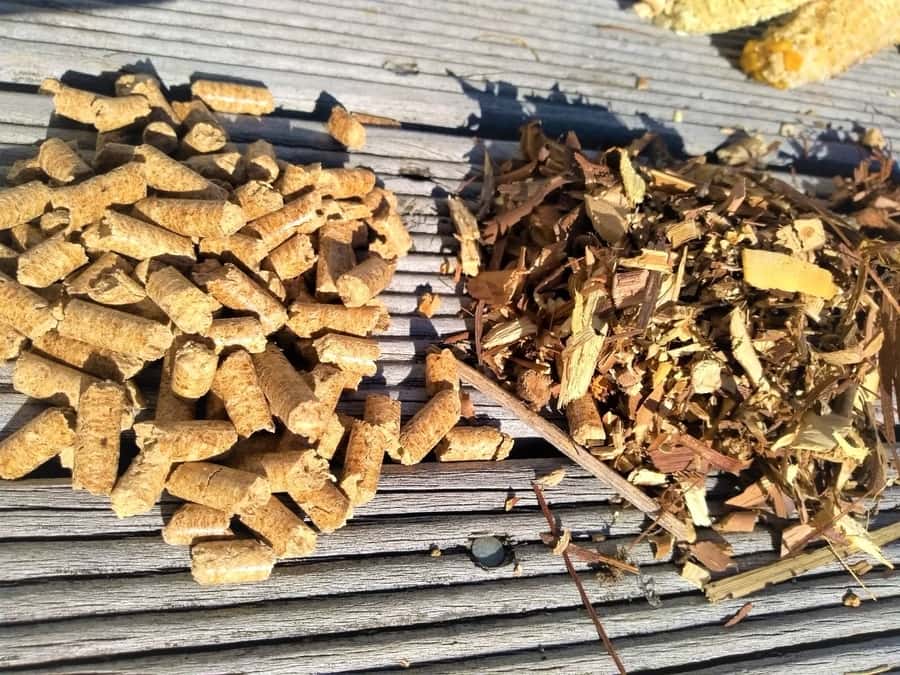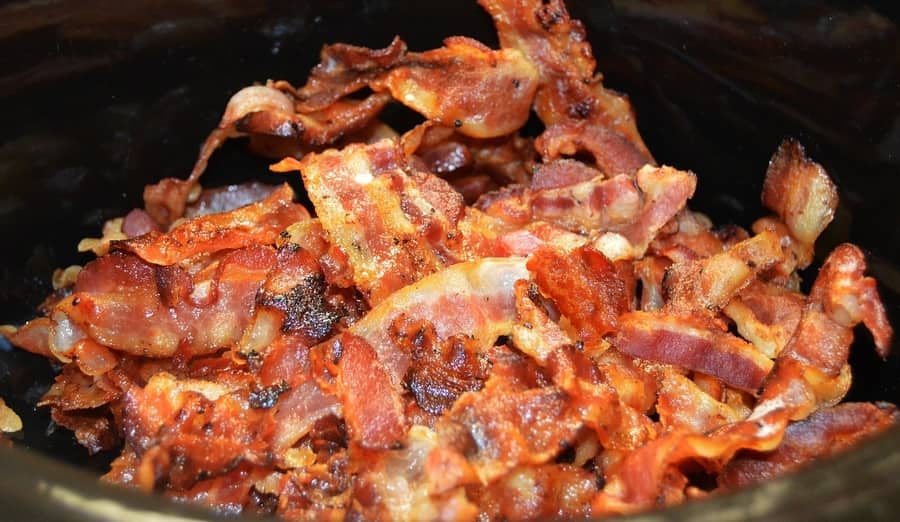Meat and wood selection can get a bit confusing. There is a vast selection, and sometimes, I buy it. Sometimes, somebody trims an apple tree or grapevine, and I get ample wood stock.
Blind taste tests have highlighted the variations, mainly whether it’s a ‘light’ or a ‘heavy’ hardwood. However, the internet reviews of woods I have been reading are trying to break down the flavors, it’s not consistent in any way.
I want to be as helpful as possible, from experiencing smoked meats worldwide and making every style of smoked meat over the decades. This article will give you a solid base of knowledge.
Whatever the smoking project you are doing, whether it’s hot smoking, low and slow, or cold smoking, these are the woods that will work for beef, pork, fish, poultry & game – I’ve summarized in tables and will expand on the information below.
| Meat | Smoking Wood Type |
|---|---|
| Salmon | Alder, apple, cherry, oak |
| Turkey | Peach, apple, cherry |
| Beef | Apple, beech, oak, hickory, mesquite, pecan, maple |
| Poultry | Apple, cherry, peach, apricot |
| Red Meat and Wild Game | Oak, beech, olive wood, hickory, pecan, cherry, grapevine |
Some like to divide the wood into a light to substantial range. Again, it is tough for anyone to guess the type of wood.
- light/subtle – apple (medium also), fruit woods (many are medium also)
- Medium – alder, European beech, olive wood, pecan, maple, oak, apricot
- Heavy – hickory, Walnut, Mesquite (better to mix)
The size and shape of the wood can also impact the smoke produced and vary depending on your smoker.
| Size | Usage |
|---|---|
| Sawdust | Portable smokers, maze-style burners |
| Small Chips | BBQ grills, smoke generators, charcoal smokers (kettle/drum etc) |
| Wood Pellets | Pellet smokers, tube smokers, charcoal smokers |
| Wood Chunks | Charcoal Smokers, Offset Smokers |
| Wood Planks | Very light smoking; soak for use on BBQs to delay combustion, often used with fish |
I’ll also try and talk about smoking wood to avoid it later below in the article.

These hardwoods below I would consider these for just about any smoking session. Don’t get too caught up on the wood; hopefully, get onto the curing and smoking!

Wood selection is one aspect. If you buy wood from a store, it will be ready for use if you buy the right size wood for your smoker. I will elaborate on this below so you can start smoking.
For the beginner, I guess the assumption is that a lot of smoke is best—bellows of white smoke.
The term “thin blue smoke” means the heat is hot and clean and the wood is burning nicely. The smoke should be transparent, which is a good sign you get clean smoke. I will get more into this detail at the end.
Key Points for Smoking Woods
As an overall guide, the denser the meat, like beef and pork, the stronger the smokey woods. For less dense meat, like chicken and fish, softer, sweeter woods, like common fruit woods, work very well.
Fresh Wood or Dry Wood
I believe you should always use dry wood; fresh wood (or green wood) has a lot of moisture and can produce unsavory flavors.
From what I have learned, soaking wood barely penetrates the wood, so there isn’t much point to it. It delays the smoking, often adding steam from the water in the wood.
Woods to Avoid When Smoking Meat
Sap or wood with resin is a general rule of thumb to avoid.
‘Evergreen’ wood that doesn’t lose its leaves in winter is often wood to avoid.
Of course, you do not want to use any treated wood, plywood, or chemicals added.
These can give off bitter flavors and unwanted toxins:
- Elm
- Cedar (red cedar planks are ok)
- Cypress
- Pine
- Fir
- Redwood
- Spruce
- Sycamore
- Poison Oak
- Eucalyptus
Specific Meat and Smoking Woods
Below are some observations and notes from my experience smoking meat over a few decades with different meats.
Woods for Smoking Salmon
- Alder
- Apple
- Cherry
- Oak
Sweet, subtle woods work best with salmon. However, sweet, light woods also work well with most seafood and freshwater fish.
Woods for Smoking Turkey
- Peach
- Apple
- Cherry
Sweet & not overpowering work best from my experiences.
Woods for Smoking Brisket
- Apple (or any fruit wood for subtle flavor)
- Oak
- Hickory
- Mesquite
- Pecan
- Maple
Due to its heavy smoke and dense meat, mesquite is a Texas classic. However, it must be used carefully. I like to mix it with some ‘medium’ woods.
Wood for Smoking Poultry
- Apple
- Cherry
- Peach
- Apricot
Similar to fish & seafood, light & subtle smoke works very well. Fruit woods, in general, are a good choice.
Wood for Smoking Ribs & Red Meat
- Oak
- Hickory
- Pecan
- Cherry
- Grapevine
Difference Wood Sizes for Different Techniques
Wood Saw Dust
I use sawdust in my portable smoker; it also works for the maze-style burner.
Sawdust is the best use for these two aspects.
Small Wood Chips
A smoke generator I have explicitly needs a certain size, but it can also take on pellets. It takes longer for the pellets to light, but I get a steady stream of smoke once they are smoldering.
Wood Pellets
Used for dedicated pellet smokers, which feed slow-burning maze-style devices, and pellet tube smokers.
If you can find them, they are compact and convenient.
They need to be kept very dry.
Wood Chips
slithers of wood, they can be used straight on a charcoal BBQ, BBQ, or other form of more prolonged smoking. Being larger, they will take longer to start smoking.
Wood Chunks / Small Logs
Some people like the chunky style; they can go on the bbq flamer tamers/vaporizers directly.
When you get log-type chunks, I have only used this on charcoal smoking sessions.
Wood Planks
Since this only produces charring around the plank, it’s very light smoking and more presentation.
Direct heat on a soaked plank with some tasty salmon on top can still be a different way to share with friends.
Should I Soak the Wood Before Smoking?
Based on my experimentation, I generally avoid soaking unless it’s plank on a BBQ.
Some points of interest:
- Soaked wood can change the temperature, which means tweaking is needed
- Soaked wood steams. It doesn’t smoke at the start, so are you getting a longer smoking time or steaming it.
- Even soaking for 6 hours doesn’t penetrate the wood very much.
The technique can also influence:
- Portable Smoker (more info on portable smoker) – saw wood dust
- Tea Smoking – sawdust or green/black tea
- Pellet Smokers – pellets
- Charcoal Smoker – sawdust (quick), chips, pellets or chunks
- BBQ Gas Grill Smoker Box– chips, pellets, or chunks
- Electric & Propane/LP Smoker – chips, branded biscuits, pellets (depends on the brand of the smoker)
- Horizontal Offset Smokers – pellets, chips, chunks
Please note that below is what I prefer—I will repeat it. If you use the universal sweeter woods, you can have great success regardless.
We all react to flavor differently, and our taste buds differ, so don’t get too caught up in the recommendations below.
Specific smoking methods include pellet tube, gas/propane grill cast iron box smoking, and maze-style wood dust smoking. These might need strong/heavier hardwoods to produce a more pungent flavor of smoke – if that is what you are after.
Different Colors of Smoke from Wood
Blue Smoke – long smoking sessions
Blue-thin smoke is beneficial for long, slow smoking sessions. It’s about getting the proper airflow in and out. Getting the right temperature is much easier with gas/propane or electric. With charcoal, it becomes more of an Art!
White Smoke – short smoking sessions
It’s excellent for short, fast smoking sessions, but you don’t want it for long rib or brisket runs. It will make the meat bitter.
When I use a portable smoker for camping/fishing, I’m happy if it pumps out white smoke while some salmon or trout is cooking. It comes out great since it’s only a 15-30 minute smoking session with a wood sawdust.
Yellow Smoke
I have used local native wood like pohutakawa (New Zealand). These can give some yellow smoke, but it’s thin & light.
Related Questions
What is the Best Wood for Smoking Meat?
Certain ‘light’ hardwoods are mild and suitable for most meats. Common varieties include apple, cherry, and many fruit woods. Oak, European beech, chestnut, maple, and pecan are also universal for smoking various meats and foods.
What is the Best Wood for Smoking Turkey?
Turkey and other poultry are best smoked with mild-flavored woods. These woods include apple, cherry, apricot, and pear. Most nut woods are also mild and suitable for smoking turkey.
Oak vs. Hickory for Smoking Meat
Personal preference: many people argue over oak vs. hickory, but then you see competitions won using cherry wood, so again, I think universal woods are a good choice. Cherry can also give the meat a different color.
Are Fruit and Nut Trees Good for Smoking Meat?
A lot of fruit and nut trees are ideal for smoking – fruit trees often are lighter in smoke flavor. Nut trees have a more medium-smoke flavor.

Tom Mueller
For decades, immersed in studying, working, learning, and teaching the craft of meat curing, sharing the passion and showcasing the world of charcuterie and smoked meat. Read More

The wood dust Iv just started using is not smoking just keeps going out 🤷♂️ Really frustrating
Heya, could be damp or airflow maybe.
Drying it out in the sun a bit might help.
Good luck!
Tom